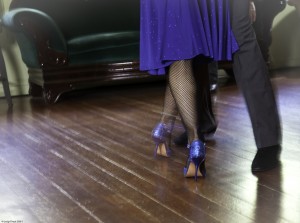 In the beginning, we all think of tango as a set of steps that must be done a certain way with our partner. We think there is a right and a wrong way. We think in terms of success and failure as we dance. We cannot help thinking in black and white terms. It is the conditioned duality of our species. However, in tango, when we get out of our conditioned mind and fully into our bodies, we get to a place where we understand the natural laws, or what we call “technique,” of tango. We stop thinking and feeling in yes/no, right/wrong, good/bad. We stop blurting out “Sorry, sorry!” when we imagine we didn’t follow or lead a step as it is supposed to be. We understand the power we have to create the dance moment by moment. I say to you this power is no less than that of the artist who paints a tableau on canvas where there was once nothing but white space.
In the beginning, we all think of tango as a set of steps that must be done a certain way with our partner. We think there is a right and a wrong way. We think in terms of success and failure as we dance. We cannot help thinking in black and white terms. It is the conditioned duality of our species. However, in tango, when we get out of our conditioned mind and fully into our bodies, we get to a place where we understand the natural laws, or what we call “technique,” of tango. We stop thinking and feeling in yes/no, right/wrong, good/bad. We stop blurting out “Sorry, sorry!” when we imagine we didn’t follow or lead a step as it is supposed to be. We understand the power we have to create the dance moment by moment. I say to you this power is no less than that of the artist who paints a tableau on canvas where there was once nothing but white space.
Yes, teachers pass on the steps, the footwork, the rhythm, and all the component parts. But when you understand this creative power you have within, you channel it through and from your partner. You stop seeing mistakes and start seeing surprises and aha and little epiphanies. In this sense, tango is no different from life or love. All of them mean never having to say Sorry!
For this reason, in tango, more so than in any other dance, we focus so intently on the embrace, the connection, the points of contact and dialog between partners, where the information is transmitted in a language that predates the spoken word.